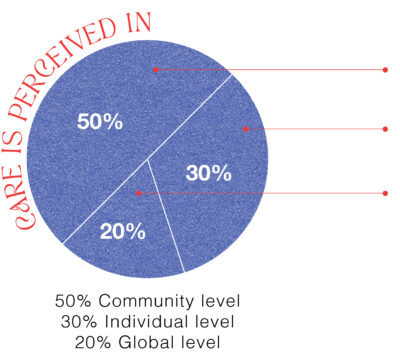
Prior to the workshop, we conducted a workshop trial that allowed us to: (1) Check if the estimated time destined for each activity was within a reasonable frame regarding the number of participants; (2) Corroborate if the instructions for each activity were clear and followed a coherent path; (3) Verify if the workshop’s workflow was conducted in a comprehensible way; (4) Have a clear understanding of whether the notion of care differed from people from diverse professional and academic fields.

PARTICIPANTS PROFILE


“Attention to happenings, sensitivity and empathy to others’ perspectives.” CLEE WANG
“Care means to look after someone. It means to keep someone else safe, healthy, and calmed.” ALBANIA ARRAZOLA
“Unconditional love and protection that a mother provides.” MICHAEL O’BRIEN
“Conscious effort to help or love.” BHARATI DAS

.
“Because being empathetic to the ones you see around is much easier.” ABHISHEK SRIVASTAVA
“It used to be more social, but my personal feeling is people are more isolated nowadays.” CLEE WAN
“I care for the environment, unidentified people, circumstances.” SANMITRA CHITTE
STAGE 1
In the following three sections or stages, we will show some of the outcomes from the workshop. In Stage 1, the participants were divided into three groups. Each group represented a level of care: group 1 as care from an individual level (micro-scale), group 2 as care from a community level (meso-scale), and group 3 as care from a global level (macro-scale). Once the participants were assigned to a breakout room, each group discussed the perception of care within the defined level. Following the discussion, the groups developed a mind map representing commonalities and clustering their findings through a visual organization of categories & subcategories.
Using Miro as a tool for conducting critical research-related workshops
Since the workshop was held online, we used Miro to create our toolset for the workshop. The purpose was to give freedom to the participants to explore and think aloud their thoughts and experiences using text, symbols, expressions (bold type, exaggerated punctuation marks, etc.) along bold arrow lines. These tools enabled the participants to highlight or tone down various elements that emerged during the discussion.
STAGE 2
In Stage 2, we developed a conceptual framework, informed by a sharing session of each group’s outcomes. A group representative walked us through their understanding of care, exploring each level: individual, community, and global. The activity was followed by a group discussion where all the participants compared the outcomes and structured the findings. We collectively selected keywords that were representative concepts from each level. These keywords were used as a proposition for the conceptual framework and its further development through a visual diagram in which multiple relations between variables are represented.
STAGE 3
Finally, after locating the key concepts that represent the preliminary framework, Stage 3 served as a crucial and closing activity where each participant could have a reflection post-workshop upon the following:
For us – as researchers, academics, and practitioners – we would like to understand and answer some questions that may provide more clarity towards the feasibility and application of this conceptual framework:
What are the possible application areas of this conceptual framework within your/our own discipline)?
Do you think this framework would help you to promote agency?
Acknowledgments
We would like to thank The Hong Kong Polytechnic University, the School of Design, and the SRC chair for providing the resources and the support for the research entailed in conducting this workshop. Equally important, we acknowledge the guidance and support from our Chief supervisor Professor Peter Hasdell to develop a comprehensive proposal for the IASDR 2021 conference. Finally, we would also like to thank Dr. ir. Gerhard Bruyns for his support throughout the process.








